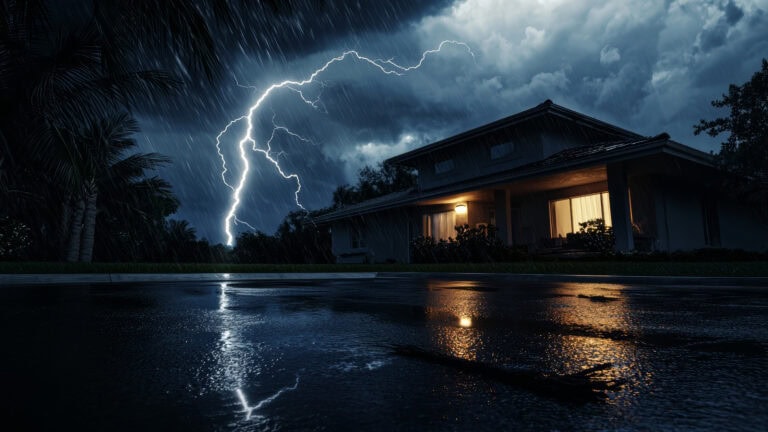If you’ve been told you need surge protection for your home but aren’t quite sure what it does, or whether it’s really worth it, you’re asking the right question.
This is one of the most common electrical safety topics Florida homeowners bring up, and unfortunately, it’s also one of the most misunderstood.
So today, let’s answer it clearly and without the hype: Is surge protection right for you?
This guide will walk you through how surge protection works, what it can (and can’t) do, and the real factors to consider, so you can make an informed decision for your home.
What Is Surge Protection?
Surge protection helps prevent damage caused by sudden voltage spikes in your home’s electrical system.
These surges can be caused by a variety of things, including:
- Lightning (indirect strikes)
- Downed power lines
- Animals (like squirrels or birds) interfering with power equipment
- Utility switching or equipment failure
- Large appliances cycling on and off
Surges don’t have to be dramatic to cause issues. Some are short and barely noticeable, but over time, they can wear down sensitive circuits and components throughout your home.
Important to Know: Not All Surges Come Through Your Electrical Panel
One of the biggest misconceptions about surge protection is that if your main panel is protected, your devices are 100% safe.
That’s not always true.
Many modern appliances and systems—think security systems, smart thermostats, cable boxes, and even garage doors—aren’t just connected to your electrical system. They’re also linked through:
- Cable lines
- Internet or phone lines
- Satellite connections
- Ethernet or data wiring
These alternate paths are also potential entry points for surges, and a panel-based surge protector won’t block them.
So while whole-home surge protection can reduce your risk, it doesn’t cover everything. For full coverage, you may also need point-of-use protection for specific systems.
Do Surge Protectors Protect Against Lightning?
Here in Florida—where we see more lightning than anywhere else in the country—this is a natural concern.
Let’s be clear:
No surge protector can prevent damage from a direct lightning strike.
A direct hit carries millions of volts, far beyond what any residential system can handle. Even the best surge protection devices are designed to handle only moderate to high surges, not the full force of a bolt from the sky.
However, indirect strikes—like those hitting a power line down the street—can cause powerful surges that do travel into homes. These are more common and are where surge protection can actually help.
To Unplug or Not to Unplug Appliances for Safety? What Florida Homeowners Need to Know
So, What Does Surge Protection Really Do?
Surge protection isn’t about making your home “surge-proof.” It’s about reducing risk, especially from the kinds of unpredictable events that happen more often than you think.
It can help:
- Limit the damage from utility-side surges
- Add a layer of protection for major appliances like HVAC systems, refrigerators, or electric ranges
- Reduce strain on electrical components that degrade over time from minor surges
But it’s not a guarantee. It’s one piece of a broader safety and maintenance strategy.
You may also be interested in: What Do Surge Protectors Protect?
What Does Surge Protection Cost?
Here’s what to expect if you’re considering surge protection:
- Whole-home surge protector (installed): $300–$700
- Point-of-use surge strips for devices: $20–$100
- Combination setups (panel + individual outlets): Variable, based on home size and systems
Surge protectors generally last 3–7 years and may need replacement after a significant surge.
Who Might Benefit Most?
Still wondering if you need surge protection? Surge protection might be worth considering if:
- You live in a lightning-prone area (like anywhere in Florida)
- You’ve experienced frequent outages or flickering power
- You have critical home systems (like HVAC or well pumps) you’d rather not risk
- You want to minimize wear and tear from smaller, more frequent surges
It may not be a must-have for everyone, but it can be a smart add-on for homeowners looking to protect their investment.
Final Thoughts: Should You Install Surge Protection?
Do you need surge protection? Here’s the honest answer: Surge protection isn’t required, but it can be worth it depending on your situation.
If your home has been trouble-free, your electrical system is modern, and you don’t rely on complex or connected systems, you may not need to make it a priority right now.
But if your area sees frequent storms, voltage fluctuations, or unexpected utility issues, it might be one of the simplest and most affordable ways to reduce long-term risk.
You may also be interested in: TECO Zap Cap vs. Whole-House Surge Protectors: Which is Better?
Want to explore your options without a sales pitch? Our team is happy to assess your home, walk you through the pros and cons, and help you decide whether surge protection makes sense, without pressure or obligation.

